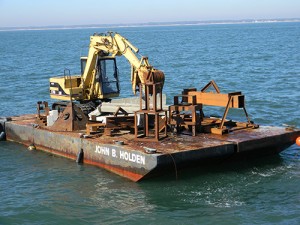
OCEAN CITY — While the Ocean City Reef Foundation continues one of its most prolific times ever, with tons of material going down on the vast network of artificial reefs off the coast of the resort, it continues to get a major contribution from an unlikely source.
For about six years, Parkside High welding instructor Biazzio “Bill” Giordano has had his students making large steel structures for the Ocean City Reef Foundation to submerge on the growing network of artificial reefs off the coast. The latest batch was recently deployed on the artificial reefs last week as part of a larger major undertaking by the foundation.
The first new truckloads of pre-cast concrete pipe recently arrived at the foundation’s staging area in West Ocean City for future deployment on the reef network. The tons of concrete pipe will be transported to the offshore sites by the 100-foot-plus “Iron Lady,” out of Salisbury, which recently conducted another major project for the Ocean City Reef Foundation.
The “Iron Lady” earlier this month dismantled the old “New Hope,” which for years had foundered along the bulkhead at the commercial harbor in West Ocean City. What could be salvaged of the “New Hope” was transported offshore and sunk over the Captain Bob Gower Reef about eight miles offshore.
In addition to the concrete pipe and “New Hope” material were the steel structures created by Giordano’s Career and Technology Education (CTE) students at Parkside High in Salisbury.
“This year, we had a couple of new designs including a pyramid style, which we hope to produce more of,” said Giradano. “We’re also doing a stack box-type reef that basically has some square tubing welded together making a fish hotel. Of course, we reuse, reclaim and recycle all of the materials, most of which comes from a major fabricator in lower Delaware.”
Under the watchful eye of Giordano, the Parkside High welding students are creating structures that will ultimately find their way to the ocean floor of the coast of Ocean City. The relationship is mutually beneficial as the Reef Foundation gets the structures to add to its artificial reef network and the high school students get to apply their lessons to a real world application. Giradano’s students are also making steel forms that could be used to create concrete structures for the artificial reefs in the future.
“We are currently making a form that will allow us to make a concrete pyramid type with openings for fish to hide and grow,” he said. “This form will be reusable and hopefully I can establish contacts with local concrete suppliers to have the forms on site and if trucks return with additional material, it can immediately be poured into the form.”
The students are using a combination of welding skills to assemble the reef structure. They used basic stick welding, but were also able to refine their semi-automatic processes of gas-shielded flux core and flux core-type welding. Whatever process the students use, they make the welds as if they were going to be inspected and not sent to the bottom of the ocean.
“By having a practical application for their training, they get real world experience,” he said. “One thing for sure though, it doesn’t matter if it is going to the sea floor or out where everyone can see, each weld is done to the acceptance criteria set forth in our structural code.”
Creating structures for the artificial reef network off the coast of Ocean City is just one part of the Parkside students’ real world applications of the lessons learned at the school.
“As welders, we are always working toward giving back and taking on projects like the reef building or preserving a piece a piece of history, like maintaining historic Chesapeake Bay skipjacks,” he said. “We have just finished producing the winches, or winders as they call them, for the skipjack ‘Catherine’ and switching out the steering on the ‘Helen Virginia,’ both of which are oyster-dredging sailing vessels.”
Giordano and his students have another special project in mind for the Ocean City Reef Foundation, but are looking for a little help from the private or public sector to help them accomplish it.
“We have a special project in the works this year for the reefs,” he said. “I am looking for two propane tanks three-foot in diameter and 12-foot long. We are going to turn them into a version of a submarine to be sunk. I do not have any material, but maybe someone or a gas company could drop off a couple for use to use for the project. Naturally, any additional tanks we could weld on for dramatic effect. I am thinking a 20,000 Leagues Under the Sea-looking sub. It should be interesting.”
During the last 17 years, the Ocean City Reef Foundation has submerged tons of material, from old boats to retired military equipment to discarded construction materials, to create a vast artificial reef network off the coast. The artificial reefs have enhanced habitat for fish and other sea creatures up and down the food chain, while improving fishing and diving opportunities.

